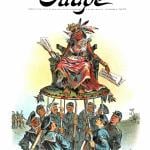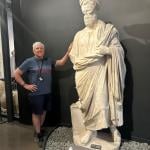Some people go to Cancun on their Spring Break; others go to Myrtle Beach. We went to Baltimore. My wife and I are both interested in medieval art, and the Walter Art Museum there is featuring a big exhibit of medieval reliquaries. That is, containers for relics, bones and other remains of saints that played a big part in medieval spirituality, and, indeed, in Roman Catholicism to this day.
The containers ranged from mini-tombs to realistic statuary. (The arm and hand pictured below used to contain an arm bone of a saint. The priest would wield it to touch the sick and other worshippers, who considered that it was the equivalent of being touched by the late saint.) They were quite well-crafted and beautiful, considered as works of art. But the show made me intrigued with the whole practice of the veneration of relics.
What surprised me is that some of the reliquaries still contained relics! I saw the tooth of John the Baptist! Another tooth of Mary Magdalene! And splinters from the True Cross displayed behind glass that was worked into an elaborate gold cross. Other relics were tiny bits of bone that were wrapped in colored cloth, with a label identifying the saint they belonged to. Even today Roman Catholic altars have to contain some relic of a saint, if not a fragment of his or her body, a “contact relic,” which is something that once touched the saint. (A scrap of cloth from the saint’s clothing, or the like.)
Now a good many of these relics are obviously fake. For example, I saw the sindarion, a cloth that supposedly wiped the face of Christ, leaving a miraculous image. At the museum it was displayed in an ornate frame behind cloudy glass, and one could indeed see the face of Jesus, but instead of looking like a photograph, it was an image that conformed–surprise, surprise–to the style of late medieval paintings. I learned that the sindarion was a very popular kind of icon, which meant that there must have been quite a few of them. One question of my Catholic friends: If an altar requires an icon, if the icon is spurious, does that invalidate the altar and its sacraments? Surely not. But why not?
According to the exhibit, the value of a relic is not just as a historical artifact to encourage one’s faith–as in, “wow, that saint really lived, and all this stuff really happened”–but rather, it is thought that these objects have some sort of spiritual power. So surely an object that is not actually a relic cannot have that power.
Certainly some of the relics are authentic, particularly the remains of contemporary people who had been canonized. Apparently, the practice is to dig up the grave of a person who has been named a saint, and to break up the body or the bones, distributing them as relics. At the end of the exhibit we saw a modern reliquary containing the brown, desiccated finger of Elizabeth Seton, the 19th century American who was canonized not long ago. I found that macabre. Another question to my Catholic friends: Why is it wrong to desecrate bodies in general, but that it is all right to do that to saints? Is that what is in store for the body of Pope John Paul II? It has been announced that it will be disinterred for the canonization ceremony.
Another modern relic on display was a bone from Francis X. Seelos, a 19th century priest with local ties, who served in the Baltimore area. He has been beatified and awaits full canonization from the Pope, which is pretty much a done deal since two miracles have been attributed to him. As I was marveling at this relic, an elderly woman with a European accent who was standing beside me asked if I were Catholic. I said, no. She said that she had prayed to Father Seelos, and he healed her son of cancer. Then she caught herself and said, well, God healed him, but Father Seelos interceded for him.
I know quite a few evangelicals and Lutherans and others who have converted to Roman Catholicism. I understand the appeal of the great intellectual tradition, the scholastic theology, the aesthetics, the ceremony, the history, and the like. What I don’t get, though, is the popular piety. Again, any of you Catholic readers, please explain it to me.
In the meantime, I have to say that the exhibit, fascinating as it was, brought out even more the Lutheran in me.

Treasures of Heaven · The Walters Art Museum.













